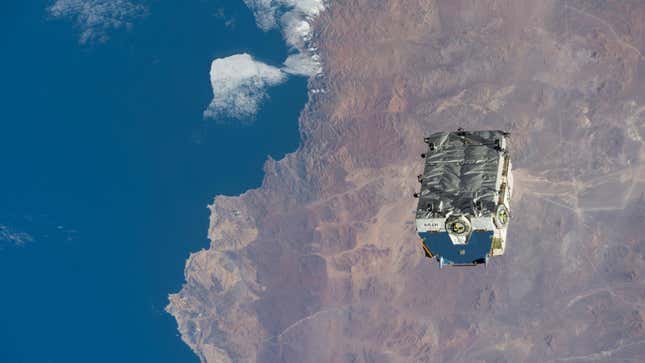
On Friday, March 8, a pallet of used batteries from the International Space Station (ISS) reentered Earth’s atmosphere over the Gulf of Mexico following an unpredictable journey through orbit.
The pallet contained nine batteries and weighed in at 2.9 tons. It had been tossed by the Canadarm2 robotic arm in March 2021 and and has since been tumbling towards Earth in an uncontrolled reentry. The chaotic fall through orbit finally came to an end last week when the cargo pallet reentered on March 8 around 3:29 p.m. ET somewhere above Cancun and Cuba, according to Jonathan McDowell, an astrophysicist who has been tracking the piece of ISS trash.
It’s not clear, however, whether the entire pallet burned up upon reentry through Earth’s atmosphere, or if some parts of it survived the heat. The European Space Agency (ESA) was also monitoring the pallet’s reentry and estimated that some parts may reach the ground but that the likelihood of a person being hit were very low. There have been no reports of injuries or damage since the object returned to Earth.
The pallet is the largest object ever thrown out from the ISS. It was launched to the space station in May 2020 by a Japanese cargo ship to help astronauts replace the old nickel-hydrogen batteries with new, more efficient lithium-ion batteries. These batteries store energy collected by the station’s solar arrays.
It wasn’t meant to end this way for the older batteries, which were supposed to be placed inside a Japanese HTV cargo ship for proper disposal. However, a backlog in the disposal of this type of equipment from the ISS forced NASA to simply toss the batteries inside a cargo pallet using the space station’s robotic arm, which led to their uncontrolled reentry.
The uncontrolled reentry of massive objects such as the battery pallet is fairly uncommon, and most objects that do meet their demise through Earth’s atmosphere usually burn up with no trace left behind. Space agencies commonly accept a 1-in 10,000 probability threshold for the casualty risk of a single uncontrolled reentry, according to ESA. As the space industry continues to grow, it might get trickier to monitor who’s sticking to the rules, which could eventually result in new regulations.
For more spaceflight in your life, follow us on X and bookmark Gizmodo’s dedicated Spaceflight page.

